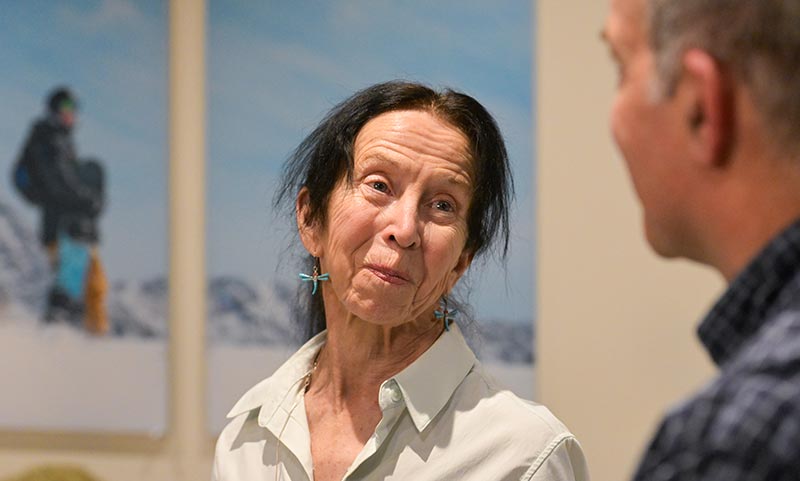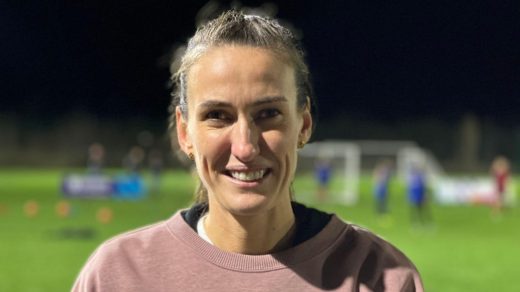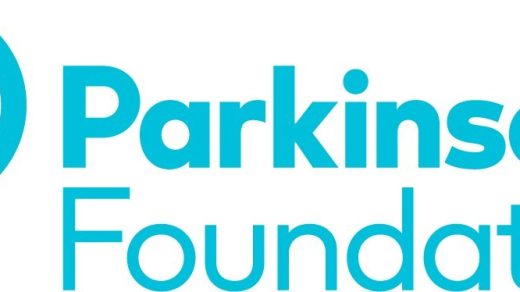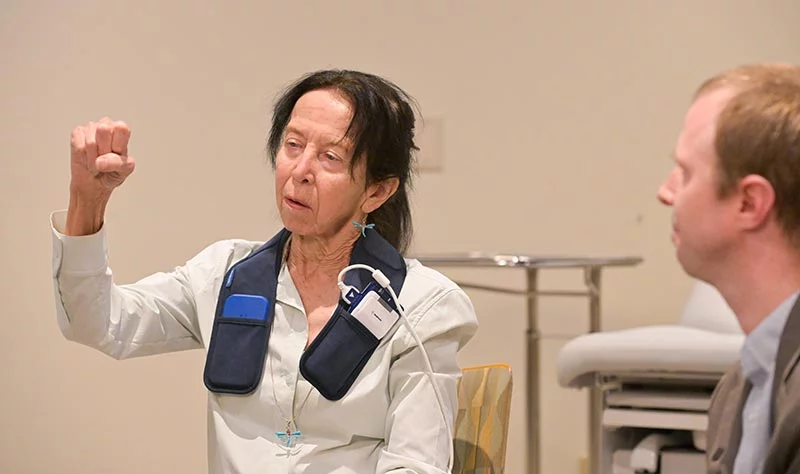
Deep brain stimulation, or DBS, involves implanting one or two electrodes into structures deep in the brain in a minimally invasive procedure. Pulses of electricity delivered by a battery-powered pulse generator implanted below the collarbone then transmit the equivalent of white noise to drown out harmful signals from clumps of thousands of damaged neurons.
While there’s no cure for Parkinson’s disease, medications and DBS can help manage symptoms and improve quality of life for the roughly one million people in the United States who have been diagnosed with the disease. DBS can quell tremor, boost slow movement (called bradykinesia), and ease rigidity – all Parkinson’s hallmarks.
DBS has been life-changing for many since its approval for Parkinson’s back in 2002. That’s despite what now looks like a shortcoming: DBS has operated much like a car with a handful of preset speeds despite neurological environments that can range from stop-and-go traffic to long trips along lonely interstates.
The mismatch between the brain’s operating environment and DBS stimulation can bring dyskinesia – uncontrolled muscle movements – if the DBS pulses are too potent, or slow movement and stiffness if they aren’t stimulating enough.
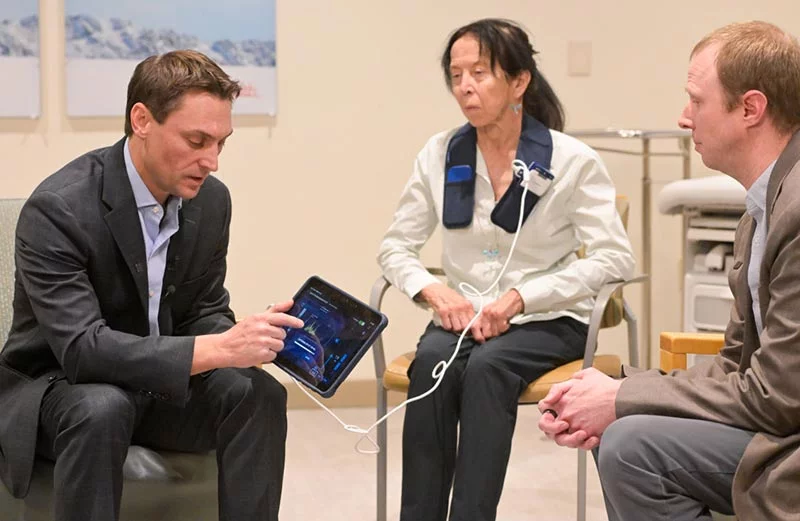
Monopolar sensing and adaptive DBS hit the streets
Of course, it’s a lot harder to measure and characterize specific frequencies of brain activity – measured in thousandths an ampere amid the cacophony of electrical activity typically happening between the ears – than it is to check a speedometer. A team of University of Colorado School of Medicine neurologists managed to do exactly that, and their work (called electrode identifier or monopolar sensing) proved fundamental to adaptive DBS, or aDBS, which the U.S. Food and Drug Administration recently approved.
Monopolar sensing helps the clinician identify the best spot in the brain to stimulate, which is important for applying aDBS that can dynamically adjust the power and duration of its white-noise pulses based on the potency of those harmful brain signals.
The system rolled out at 23 U.S. medical centers on March 24, with many more to follow in the coming months.

UCHealth University of Colorado Hospital on the Anschutz Medical Campus counts among those institutions. As a nod to the pathbreaking work of CU School of Medicine movement disorders neurologist Dr. Drew Kern and his colleague and PhD clinical neuropsychologist John Thompson, UCHealth University of Colorado Hospital became the first institution in North America to turn on aDBS as an FDA-approved treatment on Friday, March 21.
A patient named Kate Goes In Center, 75, of Denver, volunteered to be the first patient. The retired software engineer arrived at the UCHealth media center just before noon that day with partner David Julie. Several TV cameras had awaited her. Her trim frame hinted at her decades as an avid runner. In 2019, she was diagnosed with Parkinson’s disease. Continued exercise and medications kept her symptoms manageable for a few years, but by mid-2023, she opted for DBS, which CU School of Medicine neurosurgeon Dr. Steven Ojemann implanted. Kate opted for a Medtronic device whose electrodes included sensors that could detect the brain’s electrical activity as well as deliver DBS pulses.
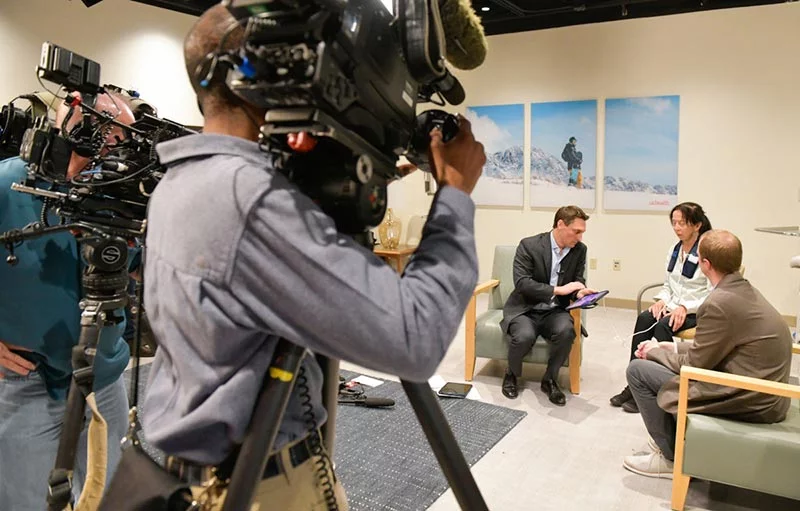
A bet on the future of aDBS
While research on ways to use such sensors to customize DBS based on the user’s state of mind had been ongoing, there were no applications yet for patients like Kate.
“She was not getting consistent control of her symptoms with medication, and so Dr. Kern suggested DBS,” David said, “She thought about it for close to a year, and decided to do it. She considered different vendors, and she liked this one because it has sensing, and it had the future potential for adapting the stimulation, and so that was why she chose it.”
Turns out to have been a good bet. Groups around the world were working on various aspects of aDBS, including Kern’s and Thompson’s, which had been researching monopolar sensing for two years at that point already.
On March 21, that future had arrived. Kate showed up unmedicated as requested, but with her DBS operating as it had for close to two years — in one of four steady settings that she could choose from via a mobile app. The settings, as well as the upper and lower boundaries of each, had been established through hours of setup and refinement with Kern and colleagues in the clinic.
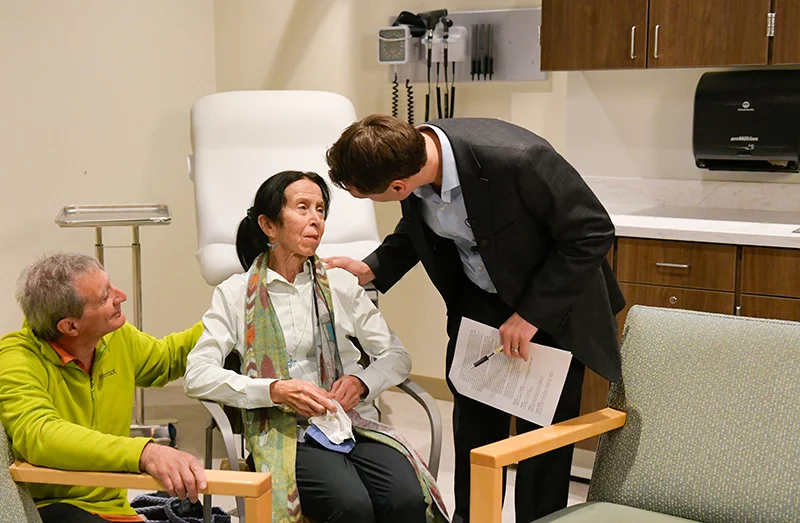
aDBS is like a pacemaker for the brain
Kern draped what looked like a short, navy-blue scarf with a pocket on each end around Kate’s neck. Thompson slid a wireless device into the pocket above Kate’s implanted pulse generator and, via a tablet, instructed the pulse generator to stop the continuous DBS (cDBS).
Kate’s chin tremor, which makes it hard for her to talk and swallow, launched, as did tremors in her left hand and leg. Finger taps, foot stomps, a short walk, and other physical tests Kern administered demonstrated stiffness and slowness of movement.
With a few taps, aDBS kicked into gear. It involved a baseline of pulse stimulation and then greater stimulation when a certain frequency corresponding to the bad signals from deep in Kate’s brain (beta waves from 13 to 30 Hertz from the subthalamic nucleus, or STN) spiked. Her tremors ceased, her fingers tapped quickly, her feet stomped hard, and she could walk easily.
“Your brain is telling this device what to do – when you need it and when you don’t need it,” Kern told her.
Someone asked Kate how she was feeling.
“A lot better than when I came in,” she said, her voice stronger than before.
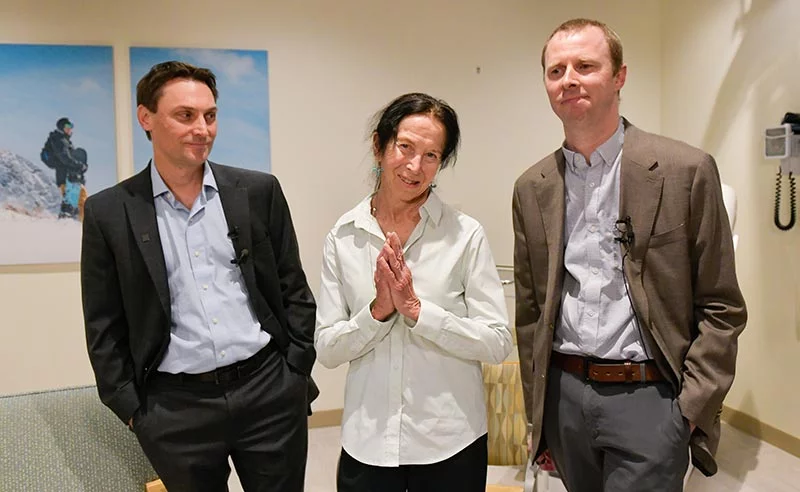
Only the beginning for promising aDBS technology
Kern and Thompson emphasized that it’s still early days for aDBS. There are other malign brain frequencies that aDBS could potentially sense and counteract in the future. There’s contextual information that could come into play in programming and adjusting the devices, such as patterns of the patient’s daily living and symptom profile that other devices may detect, Thompson said. There are ongoing investigations on how aDBS could improve sleep and gait among Parkinson’s patients.
It’s already clear that the monopolar sensing Kern, Thompson and CU School of Medicine colleagues pioneered has the potential to make huge difference in how quickly DBS can be programmed and adjusted. They’ve reported that monopolar sensing’s ability to inform DBS programming with real-time brain activity cut initial programming time from an average of more than two hours to just 18 minutes – and with more precision.
“It’s better than I can get done in a clinical setting,” Kern said.
He says that combining that sort of efficiency boost with aDBS’s ability to reduce medication needs by what Kern estimates to be 50% to 75% could sharply lower the ongoing cost of Parkinson’s care.
Kate’s partner David said the couple is hopeful that aDBS makes a difference “because her symptoms changed so much from minute to minute.”
“In the last few years, because of Parkinson’s, there’s been so much change in what she can do,” he said. “And, you know, we have two grandsons that we want to see and play with, and hopefully, this will make that happen.”
Kate added that the challenges of Parkinson’s had, at one point, pushed her to the point of giving up.
“This really makes a difference. I feel like I can do anything,” she said. “It gives me hope.”
